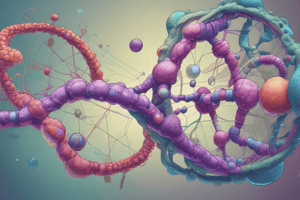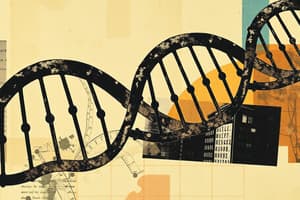Podcast
Questions and Answers
Which molecule is primarily broken down by helicases during DNA replication?
Which molecule is primarily broken down by helicases during DNA replication?
- Phosphates
- Protein
- Hydrogen bonds (correct)
- RNA
Adenine and guanine are held together by two hydrogen bonds.
Adenine and guanine are held together by two hydrogen bonds.
False (B)
What is the role of topoisomerase during DNA replication?
What is the role of topoisomerase during DNA replication?
To reduce torsional strain by introducing transient breaks in the DNA.
DNA is composed of deoxyribose sugar, phosphate, and a __________ base.
DNA is composed of deoxyribose sugar, phosphate, and a __________ base.
Match the following terms with their descriptions:
Match the following terms with their descriptions:
During which phase of the cell cycle does DNA replication occur?
During which phase of the cell cycle does DNA replication occur?
Chromatin must condense to form chromosomes before DNA replication can occur.
Chromatin must condense to form chromosomes before DNA replication can occur.
The sugar-phosphate backbone of DNA runs __________ the nucleotide bases.
The sugar-phosphate backbone of DNA runs __________ the nucleotide bases.
What is the primary role of primase during DNA replication?
What is the primary role of primase during DNA replication?
The leading strand is synthesized discontinuously while the lagging strand is synthesized continuously.
The leading strand is synthesized discontinuously while the lagging strand is synthesized continuously.
What fills the gaps left by RNA primers on the lagging strand during DNA replication?
What fills the gaps left by RNA primers on the lagging strand during DNA replication?
The enzyme that seals the nicks between Okazaki fragments is called _____ .
The enzyme that seals the nicks between Okazaki fragments is called _____ .
Match the following enzymes or processes to their respective functions in DNA replication:
Match the following enzymes or processes to their respective functions in DNA replication:
Flashcards
DNA Replication
DNA Replication
The process by which a cell duplicates its DNA, preparing for cell division.
DNA Unwinding
DNA Unwinding
The DNA molecule opens up, allowing for the replication process to begin. It's like unzipping a zipper.
Origins of Replication
Origins of Replication
Specific regions on DNA where replication starts. They're rich in A-T bonds, which are easier to separate.
Helicases
Helicases
Signup and view all the flashcards
Single Strand Binding Proteins
Single Strand Binding Proteins
Signup and view all the flashcards
Topoisomerase
Topoisomerase
Signup and view all the flashcards
Replication Protein A (RPA)
Replication Protein A (RPA)
Signup and view all the flashcards
Lagging Strand Synthesis
Lagging Strand Synthesis
Signup and view all the flashcards
Elongation (DNA Replication)
Elongation (DNA Replication)
Signup and view all the flashcards
Okazaki Fragment
Okazaki Fragment
Signup and view all the flashcards
DNA Polymerase I
DNA Polymerase I
Signup and view all the flashcards
Ligase
Ligase
Signup and view all the flashcards
Telomerase
Telomerase
Signup and view all the flashcards
Study Notes
DNA Replication Overview
- DNA replication is the process where a cell duplicates its DNA to prepare for cell division.
- It occurs in eukaryotic cells' nucleus during the S phase of the cell cycle.
- It involves numerous enzymes, complexes, and regulatory mechanisms to ensure accuracy and speed.
- Understanding replication is crucial for advancements in cell therapies and cancer research.
DNA Structure
- DNA consists of a 5-carbon deoxyribose sugar, phosphate, and a nitrogenous base (purine/pyrimidine).
- Double-stranded DNA forms a double helix with two sugar-phosphate backbones on the outside and bases paired on the inside.
- DNA wraps around histone proteins to form nucleosomes, which condense into chromatin fibres and ultimately chromosomes, facilitating compact storage within the nucleus.
- Accessing DNA requires unwinding the chromatin structure.
Initiation
- Replication begins at origins of replication, typically A-T rich regions (2 hydrogen bonds easier to separate than G-C bonds with 3 hydrogen bonds).
- Each origin is used only once per cell cycle, ensured by licensing factors (pre-replication complex).
- Helicases unwind the DNA double helix, creating replication forks.
- Single-strand binding proteins prevent separated strands from re-annealing.
- Topoisomerase relieves DNA supercoils ahead of the replication fork.
- Primase synthesizes short RNA primers to provide a 3' hydroxyl group for DNA polymerase.
Elongation
- DNA polymerase adds complementary nucleotides to the existing strands.
- Replication proceeds bidirectionally from the origin.
- The leading strand replicates continuously in the 5' to 3' direction.
- The lagging strand replicates discontinuously, forming Okazaki fragments.
- DNA polymerase I removes RNA primers and replaces them with DNA.
Termination
- RNA primers on the lagging strand are removed by exonucleases and replaced with DNA.
- DNA ligase seals nicks between Okazaki fragments to create a continuous strand.
- Proofreading exonucleases correct errors in the newly synthesized DNA strand.
- Telomerase adds telomere sequences to chromosome ends in order to continue copying strands without loss.
- The process results in two identical DNA molecules, each with one old and one new strand.
Studying That Suits You
Use AI to generate personalized quizzes and flashcards to suit your learning preferences.




